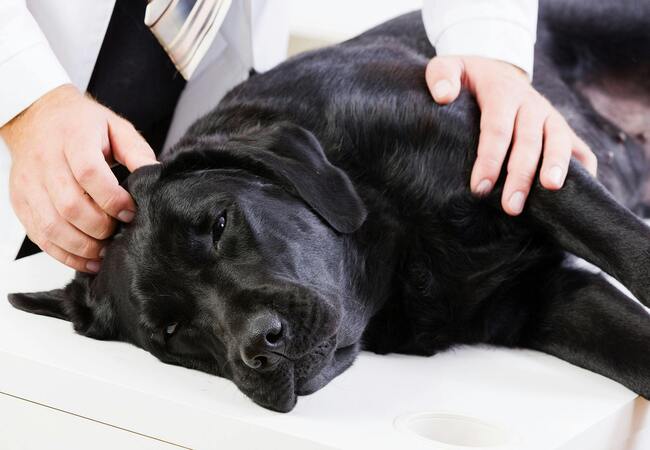Vascular Ring Anomalies in Dogs (PRAA): Veterinary Guide 2025 🩺🐾

In this article
Vascular Ring Anomalies in Dogs (PRAA): Veterinary Guide 2025 🩺🐾
By Dr. Duncan Houston BVSc
Hello, I’m Dr Duncan Houston BVSc, veterinarian and founder of Ask A Vet. In this 2025 update, we’ll explore congenital vascular ring anomalies—especially persistent right aortic arch (PRAA)—a condition where abnormal embryonic blood vessels constrict the esophagus, causing regurgitation in young dogs. Get ready for in-depth insights on causes, clinical signs, diagnostics, surgery, and aftercare, backed by expert advice and tools from Ask A Vet. Let’s get started! 💙🐶
1. What Are Vascular Ring Anomalies? 🤔
Vascular ring anomalies are congenital defects in the aorta or its branches that form a “ring” around the trachea and/or esophagus. The most common type—persistent right aortic arch (PRAA)—accounts for ~95% of cases in dogs, compressing the esophagus and leading to dilation (megaesophagus) and regurgitation .
2. How and Why It Happens ⚠️
- During normal embryonic gestation, paired aortic arches regress to form mature vessels. In PRAA, the right fourth aortic arch persists and wraps around the esophagus .
- Less common types include double aortic arch, left ligamentum arteriosum anomalies, or aberrant subclavian arteries .
- Likely genetic components—avoid breeding affected dogs .
3. Which Breeds & Ages Are Affected? 🐾
Most cases present between 2–6 months old, when puppies transition from milk to solid food . Breeds with higher incidence include:
- German Shepherds
- Irish Setters
- Boston Terriers
- Great Danes
Mixed breeds may also be affected; rare adult-diagnosed cases occur .
4. Recognizing the Signs 🕵️♂️
- Regurgitation of undigested solid food shortly after eating (not vomiting) .
- Poor growth and weight gain despite vigorous appetite .
- Gurgling neck or visible esophageal dilation on palpation .
- Aspiration pneumonia: coughing, fever, respiratory distress .
5. Diagnosing Vascular Ring Anomalies 🔬
- Radiographs with barium contrast: show esophageal dilation and narrowing at heart base .
- Thoracic X-rays: may reveal tracheal deviation and megaesophagus .
- CT angiogram: maps vessels precisely prior to surgery .
- Endoscopy: useful to assess esophageal damage and remove obstructions .
6. Treatment via Surgery 🛠️
Surgical correction is the standard treatment. A lateral thoracotomy is performed to ligate and cut the offending vessel (typically the ligamentum arteriosum or persistent arch) .
- Early intervention (<6 months) improves outcomes .
- Postoperative survival to discharge ~92%; ~87% have good long-term outcomes .
- Only ~30% achieve full reversal of megaesophagus—others need continued feeding management .
7. Post-Surgery Care & Feeding 🍽️
- Gravity feeding: use elevated bowls or Bailey chair to help food pass into stomach by gravity .
- Small, frequent meals of blended or slurry food.
- Monitor and manage aspiration pneumonia—with antibiotics and supportive care as needed.
- Repeat imaging every 2–4 weeks to track esophageal function .
- Pacify inflammation with nutrition and ancillary therapy; consider medications per vet advice.
8. Prognosis & Long-Term Outlook 📊
- Most puppies regain healthy body condition with time.
- Esophageal function continues to improve over months—but may not fully normalize .
- Persistent or recurring regurgitation should prompt follow-up imaging.
- Breeding affected dogs is discouraged, due to hereditary potential .
9. Prevention & Monitoring 🛡️
- Early diagnosis in regurgitating puppies based on breed and symptoms.
- Use advanced imaging to assess subtle anatomic anomalies.
- Avoid breeding affected dogs to reduce genetic risk.
10. Ask A Vet💡
- Ask A Vet: Telehealth pre-surgical support, post-op monitoring, and radiograph interpretation.
11. When to Contact the Vet 🚨
- Puppy regurgitates after eating solid food.
- Poor growth, frequent pneumonia, coughing.
- No improvement after 24–48 hours of symptomatic care.
- Pre-surgery questions about prognosis or feeding strategies.
12. Final Thoughts 📝
Vascular ring anomalies—particularly persistent right aortic arch—are treatable congenital conditions that can greatly improve with early surgery and structured care. Awareness of symptoms, appropriate imaging, and supportive post-operative nutrition can help puppies thrive. With guidance from Ask A Vet, tools from, your pup has the best chance at a healthy, happy life in 2025. 🐾💙
If your puppy is regurgitating or showing feeding issues, schedule a telehealth consultation via AskAVet.com. Download our app to manage feeding logs, symptom tracking, and stay on track with your pup’s recovery. 🌟






